
The collared aracari or collared araçari is a near-passerine bird in the toucan family Ramphastidae. It is found from Mexico to Colombia and Venezuela.

Ramphastos is a genus of toucans, tropical and subtropical near passerine birds from Mexico, and Central and South America, which are brightly marked and have enormous, often colourful, bills.

An aracari or araçari is any of the medium-sized toucans that, together with the saffron toucanet, make up the genus Pteroglossus.

The fiery-billed araçari is a toucan, a near-passerine bird. It breeds only on the Pacific slopes of southern Costa Rica and western Panama. The binomial commemorates the German naturalist Alexander von Frantzius.

The yellow-throated toucan is a large toucan in the family Ramphastidae found in Central and northern South America.

The green araçari, is a toucan, a near-passerine bird. It is found in the lowland forests of northeastern South America, in the northeast Amazon Basin, the Guianas and the eastern Orinoco River drainage of Venezuela. At 30–40 cm. (12–16 in) long and weighing 110–160 grams, it is the smallest aracari in its range, and among the smallest members of the toucan family.

The chestnut-eared aracari or chestnut-eared araçari is a near-passerine bird in the toucan family Ramphastidae. It is found in Argentina, Bolivia, Brazil, Colombia, Ecuador, Paraguay, and Peru.
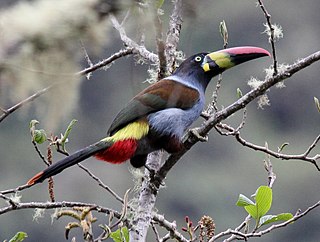
The grey-breasted mountain toucan is a species of bird in the family Ramphastidae found in humid highland forest, often at the tops of the trees, in the Andes of southern Colombia, Ecuador and Peru. It remains locally fairly common, but has declined due to habitat loss.
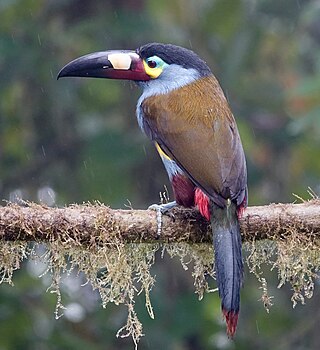
The plate-billed mountain toucan is a species of bird in the family Ramphastidae. It is native to the west slope of Ecuador and extreme southern Colombia, where it lives in the high-altitude humid mountain forests of the Andes.

The chestnut-tipped toucanet is a near-passerine bird in the toucan family Ramphastidae. It is found in Bolivia, Colombia, Ecuador, and Peru.

The scarlet-crowned barbet is a species of bird in the family Capitonidae, the New World barbets. It is found in Amazonian Brazil, Colombia, Ecuador, and Peru.
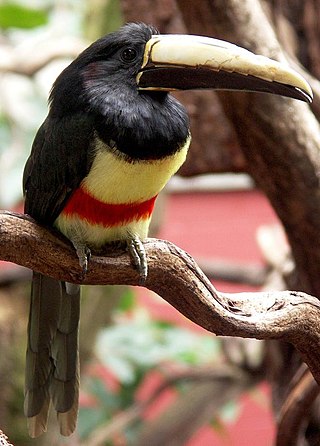
The black-necked aracari or black-necked araçari is a near-passerine bird in the toucan family Ramphastidae. It is found in Brazil, French Guiana, Guyana, Suriname, and Venezuela.

The ivory-billed aracari or ivory-billed araçari is a near-passerine bird in the toucan family Ramphastidae.. It is found in Brazil, Colombia, Ecuador, Peru, and Venezuela.
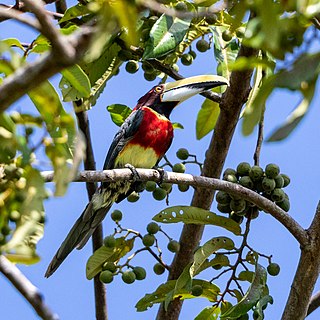
The red-necked aracari or red-necked araçari is a near-passerine bird in the toucan family Ramphastidae. It is found in Bolivia and Brazil.

The lettered aracari or lettered araçari is a near-passerine bird in the toucan family Ramphastidae. It is found in Bolivia, Brazil, Colombia, Ecuador, and Peru.

The brown-mandibled aracari is a near-passerine bird in the toucan family Ramphastidae.. It is found in Bolivia, Brazil, and Peru.

The Chocó trogon, also known as the white-eyed trogon or blue-tailed trogon, is a species of bird in the family Trogonidae, the quetzals and trogons. It is found in Colombia and Ecuador.
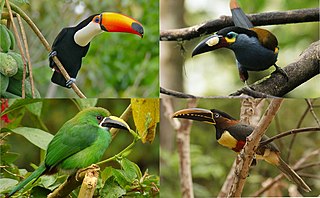
Toucans are members of the Neotropical near passerine bird family Ramphastidae. The Ramphastidae are most closely related to the American barbets. They are brightly marked and have large, often colorful bills. The family includes five genera and over forty different species.

The black-throated toucanet is a near-passerine bird in the toucan family Ramphastidae. It is found in Bolivia, Brazil, Ecuador, and Peru.

The white-throated toucanet or greyish-throated toucanet is a near-passerine bird in the toucan family Ramphastidae. It is found in Colombia, Ecuador, and Venezuela.























